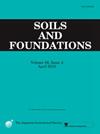Triaxial mechanical properties and microstructure of Tianjin clay stabilized with fly ash-based geopolymer
IF 3.3
2区 工程技术
Q2 ENGINEERING, GEOLOGICAL
引用次数: 0
Abstract
The triaxial mechanical properties and microscopic mechanisms of fly ash-based geopolymer-stabilized Tianjin clays with different fly ash (FA) contents, alkaline activator (AA) contents, curing times and confining pressures were investigated via triaxial and scanning electron microscopy (SEM) tests. Based on the triaxial test results, compared with the unstabilized clay, the stabilized clay exhibited a steeper stress–strain curve, a greater peak strength and pronounced strain softening behavior. A significant increase in cohesion (from 4.18 kPa to 64.5 kPa) and a slight reduction in the internal friction angle (from 30.3° to 28.6°) occurred after geopolymer stabilization. The stiffness, peak strength and residual strength of stabilized clay generally increased with increasing FA content, AA content, curing time and confining pressure. An FA/clay ratio greater than 0.1 and an AA/FA ratio greater than 0.6 were needed to achieve high strength at ambient temperature. The stabilized clay exhibited a significant strength improvement after 28 d and had a relatively high long-term strength. SEM results revealed that the chemical reactions between FA and AA led to the formation of sodium aluminosilicate hydrate (N-A-S-H) gel, which strengthened the bonds, filled the voids and reduced the porosity of the clay. As a result, the overall stiffness and strength of the stabilized clay improved. SEM analysis revealed that with a higher FA/clay ratio, a higher AA/FA ratio or a longer curing time, the geopolymerization process was more pronounced, leading to increased formation of the N-A-S-H gel and resulting in a more densely stacked and stronger bonded structure.
粉煤灰基地聚合物稳定天津粘土的三轴力学性能及微观结构
通过三轴和扫描电镜(SEM)研究了不同粉煤灰(FA)含量、碱性活化剂(AA)含量、养护时间和围压条件下粉煤灰基地聚合物稳定天津粘土的三轴力学性能和微观机理。三轴试验结果表明,与非稳定化粘土相比,稳定化粘土的应力-应变曲线更陡,峰值强度更高,应变软化行为明显。地聚合物稳定后,黏聚力显著增加(从4.18 kPa增加到64.5 kPa),内摩擦角略有减少(从30.3°减少到28.6°)。稳定粘土的刚度、峰值强度和残余强度随FA含量、AA含量、养护时间和围压的增加而增大。在室温条件下,FA/clay的比值大于0.1,AA/FA的比值大于0.6才能获得较高的强度。稳定黏土在28 d后强度显著提高,长期强度较高。SEM结果表明,FA与AA的化学反应生成了水合硅酸铝钠凝胶,增强了黏结,填充了空隙,降低了粘土的孔隙率。结果表明,稳定粘土的整体刚度和强度均有提高。SEM分析表明,FA/clay比越高、AA/FA比越高或固化时间越长,地聚合过程越明显,导致N-A-S-H凝胶的形成增加,形成更密集的堆积和更强的键合结构。
本文章由计算机程序翻译,如有差异,请以英文原文为准。
求助全文
约1分钟内获得全文
求助全文
来源期刊

Soils and Foundations
工程技术-地球科学综合
CiteScore
6.40
自引率
8.10%
发文量
99
审稿时长
5 months
期刊介绍:
Soils and Foundations is one of the leading journals in the field of soil mechanics and geotechnical engineering. It is the official journal of the Japanese Geotechnical Society (JGS)., The journal publishes a variety of original research paper, technical reports, technical notes, as well as the state-of-the-art reports upon invitation by the Editor, in the fields of soil and rock mechanics, geotechnical engineering, and environmental geotechnics. Since the publication of Volume 1, No.1 issue in June 1960, Soils and Foundations will celebrate the 60th anniversary in the year of 2020.
Soils and Foundations welcomes theoretical as well as practical work associated with the aforementioned field(s). Case studies that describe the original and interdisciplinary work applicable to geotechnical engineering are particularly encouraged. Discussions to each of the published articles are also welcomed in order to provide an avenue in which opinions of peers may be fed back or exchanged. In providing latest expertise on a specific topic, one issue out of six per year on average was allocated to include selected papers from the International Symposia which were held in Japan as well as overseas.
 求助内容:
求助内容: 应助结果提醒方式:
应助结果提醒方式:


